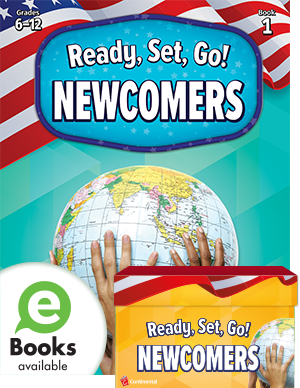Teaching Newcomers? Effective Writing Strategies for ELL Newcomers
Remember the feeling of stepping into a new classroom for the first time? You were probably excited—and a little bit nervous.
Now picture yourself walking through the doors of a new school in an unfamiliar country. Your teacher is giving directions in a language that you don’t understand. You see your classmates start to write, but you don’t know where to begin. Now you’ve really got butterflies!
Writing can be overwhelming for any student, and newcomer English language learners (ELLs) have the added anxiety of learning to write in a foreign language. Our blog will discuss top supportive writing strategies for ELL newcomers as well as engaging creative writing activities to use when beginning writing instruction.

Get Ready for Your ELL Newcomers
Your ELL newcomers arrive with a unique set of needs and strengths. Some may be highly educated in their native language, while others may have missed out on schooling due to reasons beyond their control. Many students also experience trauma during their migration to the United States.
As you get to know your newcomers, you’ll be able to determine how best to support their needs. Before they arrive, you may want to refresh yourself on the stages of language acquisition and consider the climate of your classroom.
Understand the stages of language acquisition
All English learners progress through the same stages of second language acquisition. Newcomers are in the pre-production stage, sometimes called “the silent period.”
During this stage, their receptive language skills are developing more quickly than their expressive language. Since writing is an expressive skill, it can be challenging for students at this point.
The length of time a student stays in this stage varies—much like other learning situations, it’s dependent on the individual and can be impacted by several factors. It’s also important to remember that strong first language skills help to accelerate second language acquisition.
Create a welcoming classroom
The affective filter is a theoretical term that is used to explain the correlation between a student’s emotions and their success in learning a new language.
When the filter is high, anxiety and stress may make the student reluctant to participate. When the filter is low, the student feels safe and is more comfortable taking learning risks.
How can teachers lower the affective filter so that newcomers can successfully learn? Benita Afonso, an ENL teacher from Sleepy Hollow, New York, offers this advice: “We always have to make the student feel empowered that they are intelligent and ignite their prior knowledge, regardless of the language barrier and the new country that they are in.”
Other ways to support newcomers include:
- Bulletin boards that display the languages represented by the school’s population
- International nights for families to share cultural traditions
- Culturally-responsive family engagement strategies
- Growth mindset strategies
How to Teach Writing to ELL Newcomers
As early as kindergarten, students are asked to write nearly every day. As time goes on, writing tasks become increasingly complex—which is challenging for ELL newcomers who can arrive at any time during the school year. Below are strategies for teaching writing to newcomer students.
Target lessons for their needs
When planning your lessons, take a few moments to consider how you can support your ELL newcomers’ learning goals.
- Look at the standards. When planning your writing lessons for newcomers, ELL expert Diane August recommends basing your instruction for newcomers on a lower grade level’s standards. This approach allows students to receive instruction that is complex and demanding—and builds on their skills as they work toward grade level.
- Focus on academic vocabulary. Building vocabulary is key to the success of newcomers. Teachers need to intentionally focus on developing both academic and basic interpersonal vocabulary skills. Here are a few ideas for teaching vocabulary in your lessons:
- Pre-teach vocabulary for your lessons
- Use flashcards with your students
- Include picture dictionaries in your classroom
- Have students create interactive dictionaries
- Show the patterns in language. Newcomers will benefit from learning the patterns of the English language. For example, many English words are formed from root words, base words, and affixes. Understanding prefixes, suffixes, and root words will help ELLs understand the meanings of new words more quickly.
- Teach grammatical structure. ELLs need both explicit grammar instruction and opportunities to learn grammar in context. Sheri Swearengin, an EL teacher in Marshall County schools, suggests focusing on one particular skill a week (like using a capital letter to start a sentence) so that newcomers can gradually build on their learning without becoming overwhelmed. Picture books can be an engaging resource for reinforcing grammar skills within a meaningful context.
Scaffold their instruction
Scaffolding is the process of breaking up instruction into more manageable chunks so that students can gradually build on what they know.
When they first arrive in the classroom, ELL newcomers need heavily scaffolded activities to be able to participate. And that’s okay! Over time, you’ll be able to gradually remove your support as students build their skills and grow in confidence.
Natalie Lau-Chien, a K–12 ESL teacher in New Hampshire, writes, “When teaching newcomers, my favorite scaffolding strategies include using lots of visuals, sentence frames, flashcards, videos with subtitles, and pre-teaching vocabulary with pictures.”
Below are some effective ELL scaffolding strategies to use when teaching writing:
- Allow students to use their native language. Remember that your ELLs’ first language is an asset. For students who are literate in their native language, it may be helpful to have them write in their native language first. Some students may benefit from brainstorming ideas in their native language before writing.
- Provide model texts. ELL newcomers need to see examples of the type of writing that is expected of them. Select model texts that demonstrate your learning objective so that your newcomers can see the skill in context.
- Use sentence frames. Open-ended questions can be overwhelming for ELL newcomers. Sentence frames make writing more manageable. They can also be used to reinforce academic vocabulary and promote the use of more complex language.
- Incorporate a word wall. Whether you use a bulletin board or individual folders, a word wall is an effective tool for helping students remember and apply vocabulary words. Take your word wall a step further by making it interactive—include visuals and realia to connect to your newcomers’ prior knowledge.
Adjust your assessments
Even if you and your students speak different languages, you can still find ways to assess their understanding of skills—both formatively and summatively.
If possible, consider modifying your assessments. Sheri Swearengin says, “Very new newcomers may just copy my example writing or they may illustrate what we are writing and put one of the copied sentences under their drawing.”
Natalie Lau-Chien writes, “Some ways that I modify writing assignments include simplifying the task, such as changing a task from writing a persuasive essay to writing a basic opinion paragraph about a simpler topic that requires simpler language, such as which pets are better (cats vs dogs)?”
Initially, you may consider focusing your assessment on one or two essential skills that your newcomers are learning (vocabulary, language practice opportunities, etc.).

4 Creative Writing Activities for ELL Newcomers
Newcomers can be reluctant to write for many reasons. Provide your newcomers with manageable writing tasks that are also fun—and watch their interest in writing grow. These four engaging writing activities can help to get your newcomers started.
1. Make a Recipe Book
Food can be a wonderful introduction to culture—and recipes are a perfect real-life example of nonfiction text. Consider creating a class cookbook with recipes from your students’ native cultures. After reading an article about cooking, students can make text-to-self connections by bringing in a favorite recipe from home.
2. Incorporate Journaling
Journaling is an excellent way to engage ELL students of any proficiency level. Newcomers may draw pictures and later add labels, or they can use sentence frames to help them begin. There are many different ways to incorporate journaling into your classroom—from open-ended journals to more structured formats.
3. Use Poetry
Poetry is a great way to ease your newcomer ELLs into writing. Poetry’s limited text and predictable structure naturally lend themselves to scaffolding. Be sure to begin by reading many examples of poetry to familiarize your students with the genre.
You may first create a poem as a group, then have students work in pairs or small groups to create their own. Finally, newcomers can create their own poems using sentence frames or starters.
4. Write Thank You Cards
Thank you notes are a good way to promote classroom community, practice gratitude, and spread kindness. They are brief by nature, making this an ideal writing activity for newcomers. After teaching the students the parts of a thank you note, provide them with sentence frames to help them write their own.
Teacher’s Corner
We asked members of our Trusted Advisors Group (TAG) to respond to the following question: What is the most important thing to keep in mind when teaching newcomers? Read their answers below to see what they said.
“There are so many things that we need to keep in mind when teaching Newcomers. Although it is said, “We are all teachers of ELLs”, not everyone can teach ELLs. You need to be a special kind of teacher for Newcomers. In today’s day, we need to be understanding, patient, and kind. Visuals, labels, repetition, wait time, TPR (total physical response), body language (hand gestures, body language, facial expressions), translations, recognizing their culture. All of the above mentioned are some of the important things that teachers need to keep in their bag of tricks to help all ENL students.” -Benita Afonso
“Patience, don’t try to overwhelm them or push them too fast. Make them feel comfortable and let them be a part so that they feel like they can ask questions etc.” -Sheri Swearengin
“I believe the most important thing to keep in mind when teaching newcomers is that they already come with assets (a home language, background knowledge and experiences, and possibly literacy skills in their L1). Rather than focusing on their lack of English at the moment as a newcomer, get to know them and build on the assets that they bring to develop their English language skills. For example, have them speak/write about what their home country was like, foods they eat, activities they participated in–this will build that social and cultural connection while also developing their speaking/writing skills.” -Natalie Lau-Chien

Language-centered ESL activities for students with limited English ability help develop vocabulary and life skills necessary to communicate effectively with others.
View Product →Thank you to our blog contributors: Benita Afonso, ENL/Building Point Person for grades 1 and 2 in Sleepy Hollow, New York; Sheri Swearengin, an EL teacher in Marshall County Schools; and Natalie Lau-Chien, a K–12 ESL teacher in New Hampshire.

